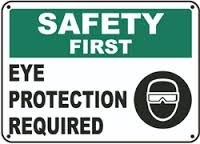Eye And Face Protection

OSHA requires employers to ensure the safety of all employees in the work environment. Eye and face protection must be provided whenever necessary to protect against chemical, environmental, and radiological hazards or mechanical irritants.
Ensuring worker safety includes conducting a workplace hazard assessment and providing adequate training for all workers who require eye and face protection. When employees are trained to work safely, through the following requirements, they should be able to anticipate and avoid injury from job related hazards.
Employers must provide training for each employee who is required to use PPE in the workplace.
Training RequirementsEach employee shall be trained to know at least the following:
All required training should be presented in a manner that the employee can understand.
Each affected employee shall demonstrate an understanding of the training specified and the ability to use PPE properly, before being allowed to perform work requiring the use of PPE.
Employers who allow their employees to wear eye and face protection on a voluntary basis when not required by OSHA or the employer must implement limited provisions of a PPE program. For all other voluntary users, an additional written eye and face protection program that covers proper maintenance procedures must be implemented.
Retraining
When the employer has reason to believe that any affected employee who has already been trained does not have the understanding and skill required, the employer shall retrain that employee. Circumstances where retraining is required include, but are not limited to, situations where:
Written Certification
The employer shall verify that each affected employee has received and understood the required training through a written certification that contains the name of each employee trained, the date(s) of training, and the subject of the certification.
Handling Emergencies
If an eye injury occurs, quick action can prevent a permanent disability. For this reason:
Ensuring worker safety includes conducting a workplace hazard assessment and providing adequate training for all workers who require eye and face protection. When employees are trained to work safely, through the following requirements, they should be able to anticipate and avoid injury from job related hazards.
Employers must provide training for each employee who is required to use PPE in the workplace.
Training RequirementsEach employee shall be trained to know at least the following:
- When PPE is necessary
- What PPE is necessary
- How to properly don, doff, adjust, and wear PPE
- Limitations of the PPE
- Proper care, maintenance, useful life, and disposal of the PPE
All required training should be presented in a manner that the employee can understand.
Each affected employee shall demonstrate an understanding of the training specified and the ability to use PPE properly, before being allowed to perform work requiring the use of PPE.
Employers who allow their employees to wear eye and face protection on a voluntary basis when not required by OSHA or the employer must implement limited provisions of a PPE program. For all other voluntary users, an additional written eye and face protection program that covers proper maintenance procedures must be implemented.
Retraining
When the employer has reason to believe that any affected employee who has already been trained does not have the understanding and skill required, the employer shall retrain that employee. Circumstances where retraining is required include, but are not limited to, situations where:
- Changes in the workplace render previous training obsolete
- Changes in the types of PPE to be used render previous training obsolete
- Inadequacies in an affected employee's knowledge or use of assigned PPE indicate that the employee has not retained the requisite understanding or skill
Written Certification
The employer shall verify that each affected employee has received and understood the required training through a written certification that contains the name of each employee trained, the date(s) of training, and the subject of the certification.
Handling Emergencies
If an eye injury occurs, quick action can prevent a permanent disability. For this reason:
- Emergency eyewashes should be placed in all hazardous areas
- First-aid instructions should be posted close to potential danger spots
- Employees must know where the closest eyewash station is and how to get there with restricted vision
- qmf7cd378aec2a07d4875f269359d53940.jpg
- co77e317df56cbceaac34052068d83c0eb.jpg
Videos
Eye and Face Protection: Personal Protective Equipment
References
https://www.osha.gov/SLTC/etools/eyeandface/employer/requirements.html
https://sielearning.tafensw.edu.au/MCS/9362/sterilisation%20disk%201/lo/7385/7385_00.htm
Categories
Preventive Maintenance
Chemical Spill
Emergency
Zero Accident Program
Hazardous Waste
Radiation
Building Code
Online R+B76eference Materials
Professional Organizations/Groups
Terminologies
DENR Requirements
Biological Safety
Radiation Safety
Smoke Emission/Respiratory Safety
Chemical Spill
Emergency
Zero Accident Program
Hazardous Waste
Radiation
Building Code
Online R+B76eference Materials
Professional Organizations/Groups
Terminologies
DENR Requirements
Biological Safety
Radiation Safety
Smoke Emission/Respiratory Safety